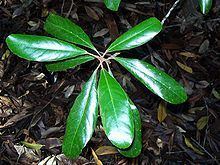Genus Elaeocarpus Rank Species | ||
 | ||
Similar Elaeocarpus sedentarius, Endiandra floydii, Randia moorei, Diospyros mabacea, Elaeocarpus holopetalus | ||
Elaeocarpus williamsianus, known as the hairy quandong is a rare rainforest tree growing in a restricted area in the far north east of the state of New South Wales. Only about one hundred trees are known to exist, occurring in three locations. This plant is listed as endangered by extinction. The habitat is rainforest regrowth in sub tropical and warm temperate rainforest, not far from the town of Murwillumbah.
Contents
Description
A small tree growing to 15 metres tall and a stem diameter of 18 cm (7 in). The tree has rusty hairs, hence the common name. The trunk is straight, with browny cream coloured bark. The small branches have reddish brown hairs.
Leaves are 9 to 18 cm long, 2 to 5 cm wide, alternate on the stem but in clusters. Broad lanceolate in shape. Leaf edges somewhat toothed, but not noticeably so. Leaf stalks 23 to 32 mm long. Glossy green above, hairy rusty brown below. Domatia can form in the axils of the leaf veins, however, they are often covered by hairs.
Flowers, fruit and regeneration
Pale green five petalled flowers form from November to December on rusty brown racemes, originating from leaf axils. The fringed petals are around 12 mm long. The fruit is a shiny blue drupe, 2 to 3 cm (1 in) in diameter, similar to Elaeocarpus grandis. Fruit ripes from April to December, but occasionally also November to December. Regeneration is erratic, but older fruit tends give the best results.
